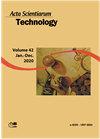Near infrared spectroscopy as a tool for agricultural expertise: identification of tomato seedlings
IF 0.6
4区 综合性期刊
Q3 MULTIDISCIPLINARY SCIENCES
引用次数: 1
Abstract
Tomatoes are one of the most prominent vegetables globally, with significant cultural and economic relevance in various nations, including Brazil. The term ‘safe food’ is becoming more popular as consumer preferences and supply chain dynamics become evolved in these processes. In light of these issues, the use of safety and quality management methods for fruits and vegetables have increased dramatically, with traceability being one of these solutions worth highlighting. When it comes to traceability, evaluation of tomato seedlings, plants, and fruits to identify groups or hybrids becomes particularly crucial throughout the marketing process, since the consumer of seedlings or fruit has difficulties recognizing whether that product truly belongs to the group indicated by the merchant. Thus, the potential of near infrared spectroscopy (NIRS) combined with the PC-LDA and PLS-DA algorithms was tested for the discrimination of two significant commercial groups, Salada and Saladete, as well as eleven cultivars belonging to these groups, which were tested for this purpose. The results show that, by using the PLS-DA model, the portable NIR equipment is capable of differentiating tomato seedlings in nurseries of the Salada and Saladete groups, with an accuracy of 99.7% and sensitivity of 100%. The technique showed to be efficient for individual models of tomato seedlings in the Salada group, with accuracy over 90% and sensitivity above 93% for all models. For the Saladete group's individual models, the technique proved effectiveness for the hybrids Parma, BS-110012, Giácomo, Guara, and Tyna.近红外光谱作为农业专业技术的工具:鉴定番茄幼苗
西红柿是全球最重要的蔬菜之一,在包括巴西在内的许多国家都具有重要的文化和经济意义。随着消费者偏好和供应链动态在这些过程中演变,“安全食品”一词正变得越来越受欢迎。鉴于这些问题,对水果和蔬菜的安全和质量管理方法的使用急剧增加,可追溯性是值得强调的这些解决方案之一。说到可追溯性,在整个营销过程中,对番茄幼苗、植株和果实进行评估以识别群体或杂交品种变得尤为重要,因为幼苗或水果的消费者很难识别该产品是否真正属于商家所指示的群体。为此,对近红外光谱(NIRS)结合PC-LDA和PLS-DA算法对Salada和Saladete两个重要的商业类群及其所属的11个品种的鉴别潜力进行了测试。结果表明,利用PLS-DA模型,便携式近红外设备能够区分Salada和Saladete两种番茄苗圃的幼苗,准确率为99.7%,灵敏度为100%。该技术对Salada组的番茄幼苗个体模型有效,对所有模型的准确率超过90%,灵敏度超过93%。对于Saladete小组的个别车型,该技术证明了混合动力车Parma, BS-110012, Giácomo, Guara和Tyna的有效性。
本文章由计算机程序翻译,如有差异,请以英文原文为准。
求助全文
约1分钟内获得全文
求助全文
来源期刊

Acta Scientiarum-technology
综合性期刊-综合性期刊
CiteScore
1.40
自引率
12.50%
发文量
60
审稿时长
6-12 weeks
期刊介绍:
The journal publishes original articles in all areas of Technology, including: Engineerings, Physics, Chemistry, Mathematics, Statistics, Geosciences and Computation Sciences.
To establish the public inscription of knowledge and its preservation; To publish results of research comprising ideas and new scientific suggestions; To publicize worldwide information and knowledge produced by the scientific community; To speech the process of scientific communication in Technology.
 求助内容:
求助内容: 应助结果提醒方式:
应助结果提醒方式:


